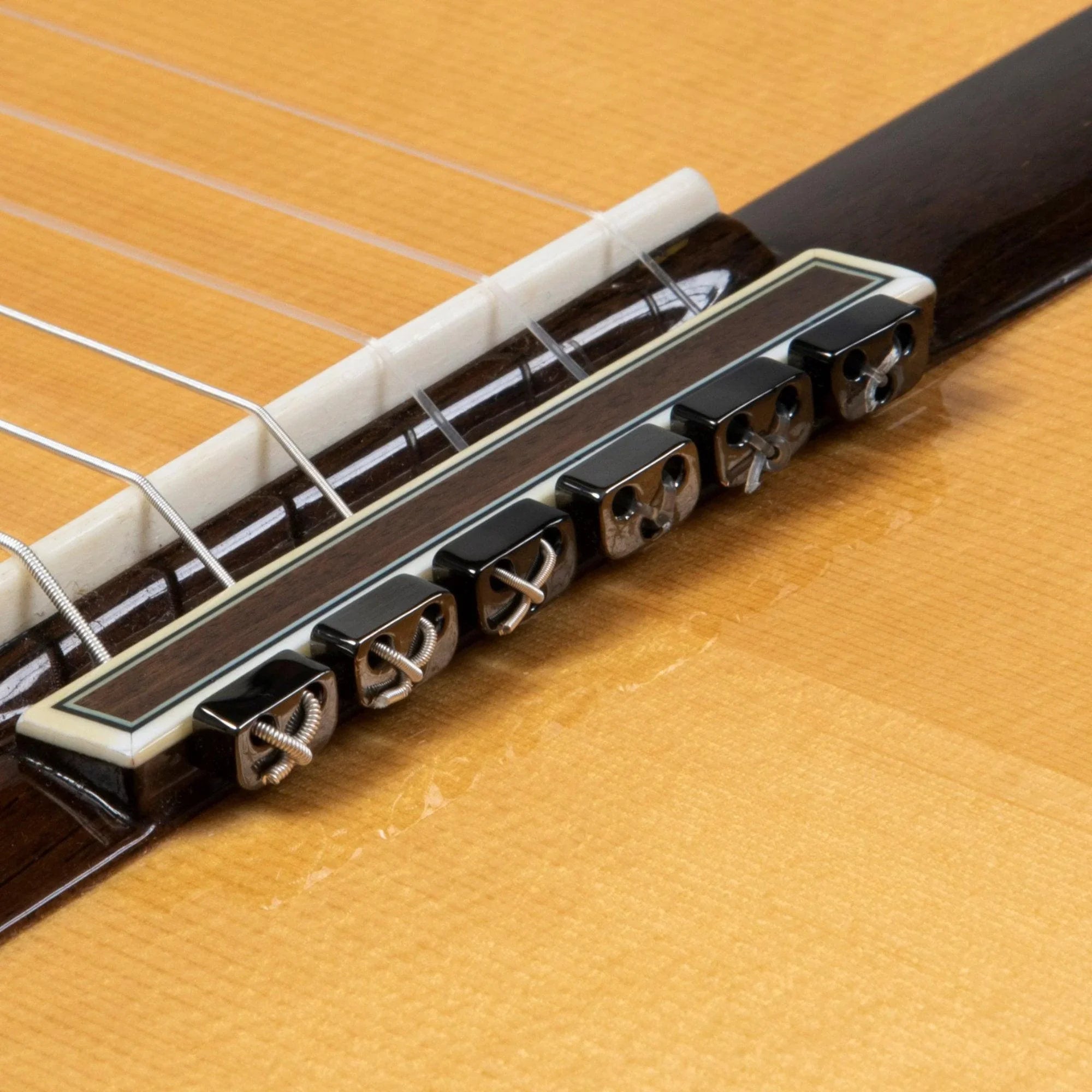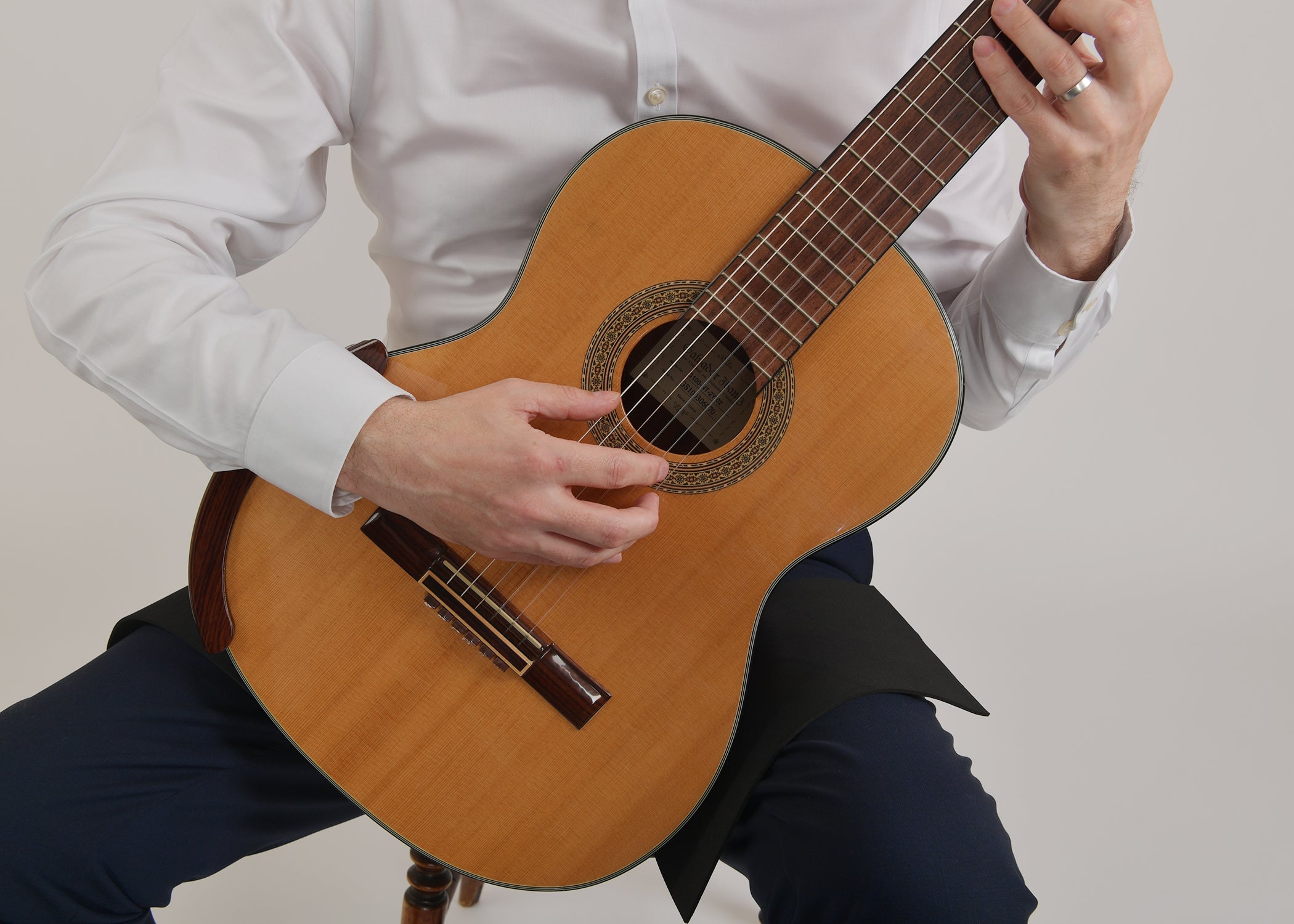Cuidar das unhas é fundamental para violonistas clássicos e flamencos. Unhas bem cuidadas ajudam a moldar o timbre, melhorar o ataque e oferecer mais controle sobre a dinâmica.
Seja usando unhas naturais, acrílicas ou até tocando sem unhas, uma rotina de cuidados adequada garante consistência na execução. Aqui está uma rotina diária e semanal de cuidados com as unhas voltada para guitarristas clássicos e flamencos.
Rotina de cuidados com as unhas para violonistas clássicos e flamencos
Manutenção diária:
Use uma lixa de unha de grão fino para suavizar qualquer borda irregular. Unhas desiguais podem prender nas cordas, causando ruídos indesejados e afetando a qualidade do som.
Hidratação:
Aplique óleo de cutícula ou creme fortalecedor de unhas para mantê-las flexíveis e evitar que quebrem.
Polimento:
Use um bloco de polimento para criar uma superfície lisa, como vidro, nas unhas. Isso ajuda a produzir um ataque mais limpo nas cordas.
Fortalecimento natural das unhas:
Tenha uma dieta rica em nutrientes para apoiar unhas fortes e resistentes e manter a performance ideal.
Evite danos:
Cuidado com atividades que enfraquecem as unhas, como lavar as mãos excessivamente, exposição a produtos químicos ou usar as unhas como ferramentas.
Para guitarristas clássicos em busca de soluções de alta qualidade para cuidados com unhas, a Alba GB oferece um kit completo que inclui tudo o que é necessário para manter unhas fortes e bem modeladas. A lixa elétrica USB da marca foi desenvolvida especialmente para guitarristas, permitindo modelagem e alisamento precisos para garantir uma superfície uniforme de toque.
Com todas as ferramentas essenciais inclusas, o kit de cuidados com as unhas da Alba GB oferece manutenção de qualidade profissional para manter suas unhas em condições ideais para uma performance impecável.
[Read Also: Plastic Guitar Beads vs Metal Guitar Beads]
É possível tocar violão com unhas longas? Sim, muitos violonistas clássicos e flamencos tocam com unhas longas na mão direita. O comprimento e formato das unhas influenciam diretamente o som e a técnica.
Uma unha bem moldada pode produzir um som quente e cheio, enquanto uma mal cuidada gera um timbre inconsistente.
Já unhas longas na mão esquerda dificultam pressionar corretamente as cordas. Por isso, a maioria dos guitarristas mantém as unhas da mão esquerda curtas para garantir uma digitação limpa e uma afinação precisa.
Como tocar violão com unhas longas Para tocar violão clássico ou flamenco com unhas longas, é essencial moldá-las corretamente. Um formato comum é o em rampa, seguindo a curvatura natural da ponta dos dedos. Isso permite uma liberação suave da corda e melhor controle do som.
Quem usa unhas longas deve focar na precisão do ataque – tocando as cordas de forma limpa para evitar ruídos indesejados.
[Read Also: Alba GB Arm Sleeves: A Deeper Look into Their History and Purpose]
Posso tocar violão com unhas longas? Com certeza, mas depende do estilo de música. Guitarristas clássicos e flamencos dependem das unhas para melhor projeção e clareza.
Por outro lado, se você toca guitarra elétrica ou acústica com cordas de aço, unhas longas podem atrapalhar. Quem toca fingerstyle às vezes deixa as unhas crescerem para maior articulação, mas para batidas fortes, unhas longas não são ideais.
É possível tocar violão com unhas acrílicas? Sim, muitos guitarristas usam unhas acrílicas como substituto das naturais. Elas oferecem durabilidade e consistência, sendo uma excelente opção para quem tem unhas frágeis ou quebradiças.
No entanto, a espessura das unhas acrílicas pode alterar a sensação ao tocar, por isso é importante moldá-las com ajuda de um profissional.
Muitos guitarristas clássicos profissionais usam uma combinação de unhas naturais com sobreposição acrílica para maior resistência.
É possível tocar violão clássico sem unhas? Sim, mas o som será diferente. Tocar sem unhas resulta em um timbre mais suave e aveludado, o que pode ser preferido em certos estilos musicais. Sem unhas, o ataque é menos pronunciado, e o som vem principalmente da polpa dos dedos.
Alguns músicos, como Tárrega, defendiam o toque sem unhas. Outros, como Segovia, confiavam nas unhas para alcançar projeção e articulação.
[Read Also: Carbon Classical Guitar Case: Style, Protection, and Comfort for Musicians]
Como tocar com unhas postiças Unhas postiças, incluindo adesivas, acrílicas ou de gel, podem substituir com eficácia as unhas naturais. O segredo está em moldá-las e lixá-las corretamente.
Muitos músicos acham que unhas de gel são mais finas e se assemelham mais às naturais, enquanto as acrílicas são mais duráveis. Ao usar unhas artificiais, é importante verificar regularmente se estão soltando ou lascando, pois isso pode afetar o som e o controle.
Como fortalecer as unhas para tocar violão Se você prefere tocar com unhas naturais, mantê-las fortes é essencial. Aqui vão algumas dicas:
Use base fortalecedora:
Aplique regularmente um fortalecedor para evitar rachaduras.
Hidrate suas unhas:
Hidrate unhas e cutículas para mantê-las flexíveis e menos propensas a quebrar.
Melhore sua alimentação:
Alimentos ricos em biotina, queratina e cálcio ajudam a fortalecer as unhas.
Lixe corretamente:
Sempre lixe em uma única direção com lixa de grão fino para evitar microfissuras.
Evite produtos agressivos:
Produtos de limpeza e exposição frequente à água enfraquecem as unhas. Use luvas ao limpar para protegê-las.
[Read Also: Classical Guitar Armrest: Comfort, Protection, and Superior Sound]
Conclusão: Seguindo uma rotina de cuidados específica, guitarristas clássicos e flamencos podem manter unhas fortes e saudáveis que favorecem sua técnica.
Seja com unhas naturais, acrílicas ou sem unhas, a manutenção adequada garante consistência no som e na técnica, permitindo que você se concentre na música sem se preocupar com problemas nas unhas.
Com o kit de cuidados com as unhas da Alba GB, você terá tudo o que precisa para manter suas unhas sempre prontas para tocar com confiança.
Guia de cuidados com as unhas para violão clássico: rotinas diárias, unhas acrílicas vs. naturais e dicas de fortalecimento. Toque com segurança e som perfeito!





Leave a comment
Este site está protegido pela Política de privacidade da hCaptcha e da hCaptcha e aplicam-se os Termos de serviço das mesmas.